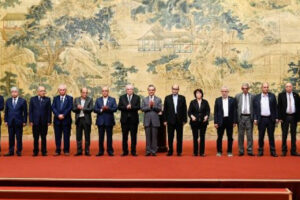DEARBORN, Mich. — Arab Americans have been advocating for a new “Middle East and North Africa” (MENA) category in the U.S. Census for at least 30 years.
Currently, the federal government categorizes anyone with origins in the MENA region, that includes at least two dozen countries and ethnic groups, as white, such as Lebanon, Egypt, Iran, Iraq, Israel, Morocco, Syria, and Yemen.
Growing up as the child of Lebanese immigrants in Dearborn, Michigan, Bilal Hammoud watched as his father struggled with health challenges.
“This experience has made me acutely aware of the vital role accurate data plays in health care,” said Hammoud, an advisory board member for Asian Pacific Islander American Vote-Michigan, a Michigan nonprofit dedicated to empowering Asian Americans and Pacific Islanders through voting and representation. “By including a MENA category in the U.S. Census, we can foster research that specifically addresses the health issues unique to the MENA community,” he said.
Basic statistics, like those found in the census, help researchers with key studies and can determine federal funding allocations, programs and policies for specific groups. But for those with roots in the MENA region, that has meant continued underrepresentation with no formal checkbox on U.S. Census and other forms, like government forms and medical paperwork.
In late January, a federal working group recommended that a new MENA category be recognized on official government documents because “many in the MENA community do not share the same lived experience as White people with European ancestry, do not identify as White, and are not perceived as White by others.”
The federal proposal is an early step in possible revisions that would lead to more accurate federal data collection for Arab Americans. There are approximately 4 million Arabs in the U.S., according to figures by the Arab American Institute, a national nonprofit focused on the Arab American community.
What are the Possible Next Steps for a MENA Category?
The proposal from the Federal Interagency Technical Working Group on Race and Ethnicity Standards under the White House’s Office of Management and Budget (OMB), is a recommendation. There are several steps before a separate MENA category could be approved ahead of the next census – in 2030.
After the period for the public to submit comments ended on April 27, the group will now review, revise, and share the new standards by 2024 with the OMB, which sets the current definitions for race and ethnicity in the U.S. for federal agency data collection, including the Census Bureau.
A separate MENA category is one of several initial proposals OMB is considering, including whether to combine the race and ethnicity questions into one question, which would impact several communities across the U.S. The OMB’s standards on race and ethnicity haven’t changed since 1997.
This is not the first time a MENA category has been proposed.
During the Obama administration, the U.S. Census Bureau did extensive testing and recommended that a MENA category be added to the census. However, when former President Donald Trump took office and after the Census Bureau said more testing was needed, the effort stalled.
In 2021, President Joe Biden’s first executive order declared his commitment to the advancement of racial equity and support for underserved communities through the federal government, which many advocates saw as an indication of Biden’s commitment to their representation.
The Biden administration published a Federal Register notice two years later, calling for public comments on the federal proposal for a distinct category for people with origins in the MENA region.
Why a MENA Category is Important
For Hammoud, the importance of having a MENA category on the census cannot be overstated.
Every state and federal agency, school and nonprofit relies on the census, he said, and the addition of a seemingly simple checkbox will open access to federal funding, protections, health care research, equity in education and more.
READ MORE: How supporting students during Ramadan helps build feelings of belonging
The specific issues people of MENA descent experience are also obscured within the larger category of “white.” Disparities in health, education, employment, housing, and civil rights, as well as stories about their experiences with discrimination do not necessarily align with those in that racial classification.
There would also be a trickle-down effect if the OMB moves forward with the change, said Rima Meroueh, director of National Network for Arab American Communities, a growing network of independent Arab American organizations around the country. It is also a part of ACCESS, the nation’s largest Arab American community nonprofit in the country that is based in Dearborn, Michigan. “A lot of state agencies want to match what federal agencies are doing, so they will start collecting [that data]. Then you have universities and hospitals that want to match what the state is doing. So they start collecting it,” she added.
Hammoud cautioned that there are some concerns over privacy and the potential misuse of ethnic data for discriminatory purposes.
“Despite these concerns, the benefits of accurate representation and data collection for the MENA community far outweigh the drawbacks,” he said.
There’s no Direct Way to Count People with Origins in the MENA Region
Right now, federal data about Arab Americans is, in part, gathered from the American Community Survey (ACS), an annual survey by the U.S. Census Bureau. Arab American organizations that serve the community, and sometimes city governments that seek and collect this info, bridge the data gaps. This overall lack of data hampers the ability of organizations and local governments to serve this specific group.
“We know that, for example, we have higher, or higher rates of, risk behaviors and chronic health conditions,” Meroueh said. “Those are all things that we are not able to have numbers for and therefore not able to strategically address the needs within our community.”
This lack of data on top of cultural and language barriers translates to poorer health care, fewer resources, and less research, Meroueh said. These are also exacerbated when physicians and other health care providers do not speak the language or understand the culture or immigration history of their patients.
Why Have Arab Americans Historically Been Considered White?
How data on race and ethnicity was recorded in the U.S. has changed over the years. Early U.S. Census categories collected information about whether people were free or enslaved, Black or white. In 1870, the U.S. Census added a category for “Chinese” and another for “Indian” (referring to Native Americans).
Today, the OMB defines “white” as people who have origins in Europe, the Middle East and North Africa.
Meroueh noted that although the definition wasn’t created by MENA people, taking people with origins in the Middle East and North Africa out of the definition of “white” is a way for Arab Americans to be better represented in federal data gathering.
“There is no MENA community per se,” Meroueh said. “No one goes around saying I am ‘MENA American.’”
There is a long history of the privileges afforded by whiteness and how it has intersected with people of MENA descent more than a century ago.
Arab American immigrants pushed against being categorized as Asian in the early 1900s, though the Middle East is located on the western end of the Asian continent. Discriminatory laws, such as the 1882 Chinese Exclusion Act, limited immigration and prevented Asians from becoming U.S. citizens and owning land in the U.S. After the Civil War, the Naturalization Act of 1870 extended citizenship to people of African descent, but it did not allow Asians or Native Americans to become citizens.
In that environment, immigrants from the MENA region leaned away from the Asian category and toward being categorized as white in hopes of receiving protection by their proximity to whiteness.
“Popular culture and political rhetoric has portrayed Arabs as anything other than white for many decades.”
“In the early 1900s, Arab immigrants were in a precarious position. Only white and Black people were able to become citizens,” Matthew Jaber Stiffler, Arab American National Museum research and content manager, told the PBS NewsHour. “Because the Naturalization Act excluded Asians, the Arab immigrant community raised money and fought in courtrooms and on newspaper editorial pages for many years to prove their whiteness. Eventually the federal government recognized that Arabs and other people of the Middle East were white, which is where we are at today, even as popular culture and political rhetoric has portrayed Arabs as anything other than white for many decades.”
In a 1909 court case, George Shishim, whose race was considered Chinese or Mongolian because he was born in Lebanon, argued in federal court, “If I am a Mongolian, then so was Jesus, because we came from the same land.”
In response to this case, U.S. citizenship was expanded to allow for Lebanese, Syrians, and all Arabs, distancing them from the discriminatory practices that would remain against Asians in the United States until 1952.
“When we talk about systemic exclusion of Black and brown communities, that doesn’t include MENA communities because we are considered white,” Meroueh said, adding that the narrative around systemic barriers also includes MENA people. “I think that narrative is one that is very different from early Arab Americans that came because there is a recognition now that we all, as Black and brown communities, are impacted by these same systems.”
Source : PBS News















